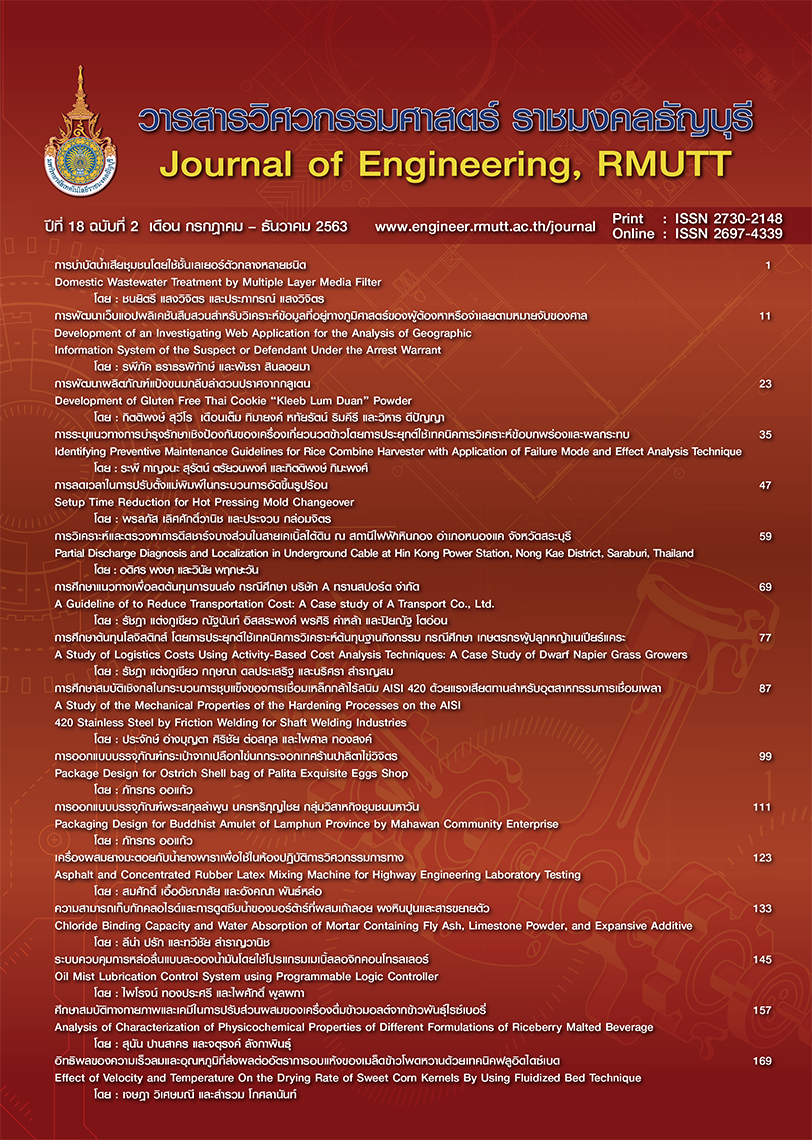Domestic Wastewater Treatment by Multiple Layer Media Filter
Main Article Content
Abstract
This research was a quasi-experimental research. The objective was to apply 3 types of media, which were oyster shells, concrete rubbish, and zeolites, which were scrap materials that were easy to found for treating domestic wastewater. The medium was contained in layers vertically in parallel. Wastewater was continuous with 19 Watt pump, the flow rate of 13 liters per minute, the hydraulic retention time of 6 days and compares the efficiency of the wastewater treatment by multiple layers between media and without media. The results showed that wastewater treatment by multiple layers with media could treat total suspended solids and orthophosphate well with the highest removal efficiency, the hydraulic retention time of 6 was 100 and 86.78%, respectively. Wastewater treatment system using layers without media can treat fat and oil well with the highest removal efficiency, the hydraulic retention time of 6 was 39.8%. Both wastewater treatments by multiple layers with media and without media. The removal efficiency of COD was not different. With statistical significance at the level of 0.05.
Article Details
The manuscript, information, content, picture and so forth which were published on Frontiers in engineering innovation research has been a copyright of this journal only. There is not allow anyone or any organize to duplicate all content or some document for unethical publication.
References
Dow Chemical Co. A Literature Search and Critical Analysis of Biological Trickling Filter Studies. Environmental Protection Agency Water Pollution Control Research Series; 1971 December. Report No.: 17050 DDY 12/71.
Canler JP, Perret JM, editors. Biological aerated filters: assessment of the process based on 12 sewage treatment plants: Elsevier.
Limtrakul J. Zeolite Chemistry. Journal of science. 1997;51(6):420-2.
Kharemdabeh Y, onthong U. Phosphate adsorption on zeolites by computation chemistry. journal of Thaksin. October 2008- January 2009;11(3). (in Thai)
Kanjanasuntorn P. The effect of media on phosphorus removal from domestic wastewater using vertical flow
constructed wetland: Chulalongkorn University; 2007. (in Thai)
Patpu P. Removal of fluoride from drinking water by volcanic rock and cockle shell:kasetsart University; 2004.(in Thai)
Tiwapat S. Study of turbidity removal efficiency by pervious interlocking concrete paving blocks with cockle seashell and green mussel: kasetsartUniversity; 2016. (in Thai)
APHA AWWA and WEF. Standard methods for the examination of water and wastewaters. 23rd ed. American Public Health Association - American Water Works Association - Water Pollution Control Federation; 2017.
Abdel-rahim MM. substainable use of natural zeolites in aquaculture: A short review. Juniper journals.2017;2(4).
Wongkitrungruang W. A Downflow biofilter using sea shells as filter media.Master’s degree in environmental engineering. Department of environmental engineering. Faculty of Engineering. Chulalongkorn university;2000. (in Thai)
Kanjanasuntorn P. The effect of media on phosphorus removal from domestic wastewater using vertical flow constructed wetland: Chulalongkorn University; 2007. (in Thai)
Ning P, Bart H-J, Li B, Lu X, Zhang Y. Phosphate removal from wastewater by model-La(III) zeolite adsorbents. Journal of Environmental Sciences. 2008;20(6):670-4.
Chan H. Removal and recycling of pollutants from Hong Kong restaurant wastewaters. Bioresource technology. 2010;101(17): 6859-67.
Sinthurat P. Improvement of effluent from domestic wastewater treatment plan using filtration concrete rubbish media: Chulalongkorn University; 2000. (in Thai)
Sakadevan K, Bavor HJ. Phosphate adsorption characteristics of soils, slags and zeolite to be used as substrates in constructed wetland systems. 1998:393.


